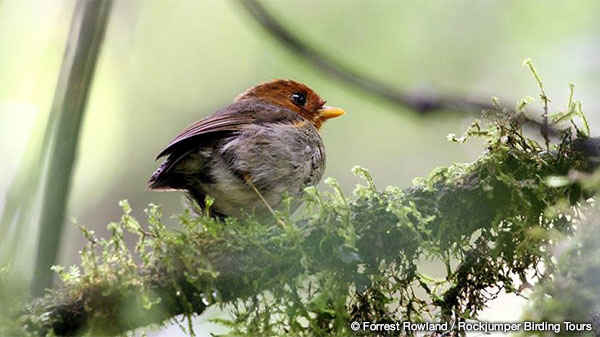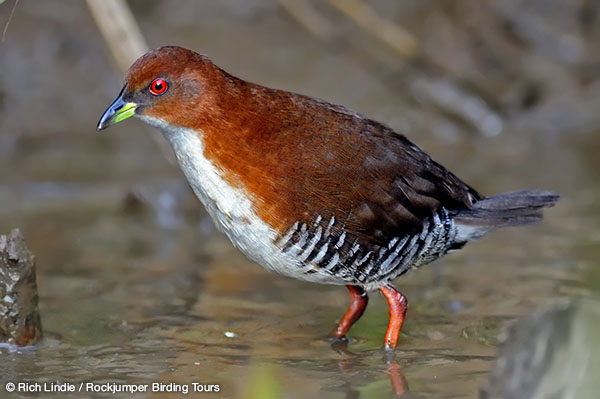
Perhaps the most challenging task for our tour leaders is to select their best bird from amongst the thousands of great specials that they have the opportunity to see on our array of tours each year. The rest of us, however, have the pleasure of reading the year’s highlights from our leaders as recorded in their own words.
Adam Riley
The African or Angola Pitta is the holy grail of the Southern African birder and definitely the “most-wanted” bird in our region. I personally hadn’t seen one for over 20 years and that was well before I was hauling around a camera! I had an opportunity to guide some local birders who were on a serious pitta-quest in early December so I didn’t hesitate to take the opportunity to try and take a photo of this stunning bird. After charter flying into a remote camp in the wilderness of Mozambique’s Zambezi Delta, we began our search. It was really dry and after 2 days we had turned up no sign of the bird except for a deserted nest from last season. I was beginning to stress… Finally, we heard a single call and after some dedicated tracking in the undergrowth everyone, except one of the group, managed to see this very secretive bird. I returned the next morning with my friend who had dipped and this time we obtained superb views of a pair and I managed to take a few photos. A great way to end my last birding adventure of the year!
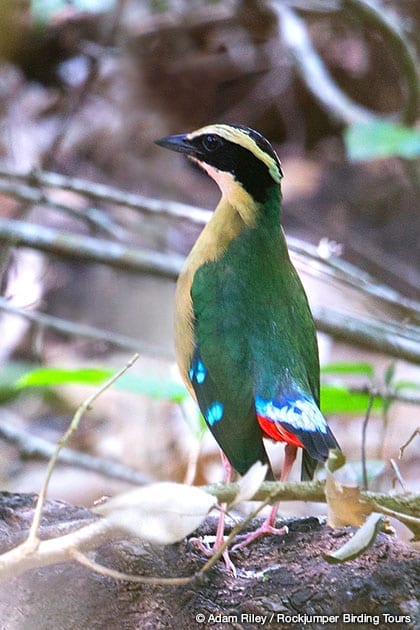
Clayton Burne
In comparison to last year, 2015 has been very quiet on the gross numbers and lifers’ front. Having curtailed my guiding activity with a move to the office in South Africa, I managed only a few new birds in Panama, Puerto Rico and Cuba earlier in the year. However, my time in South Africa has certainly not been short of birding. Almost every weekend has been spent roaming KwaZulu-Natal, hooking up with species I have not seen in over 15 years, while Megan’s recent introduction to birding has added considerable impetus to my quest to show her new lifers.
While I have rather enjoyed seeing many old friends, I did pay particular attention to finding the few species that had eluded me so many years ago. One bird, in particular, had given me quite the run-around – I lost track of the endless nights spent camping in obscure locations, the hours waiting and watching bat movements during the twilight hours and searching plantations for days on end – without luck.
The Bat Hawk was a fairly straightforward choice as my bird of the year, for there is nothing quite like finding your bogey bird after a 15-year wait – even better when you twitch said bird on your birthday!
Found in much of sub-Saharan Africa, as well as Indo Malaysia, the Bat Hawk is hardly uncommon – it was just awfully good at avoiding me! Fortunately, Bat Hawks tend to favour a particular roost site, and once found, sightings can be almost guaranteed. With much thanks to the other guides at Rockjumper who gave me a helping hand, I was finally able to twitch what had been a long time bogey bird!
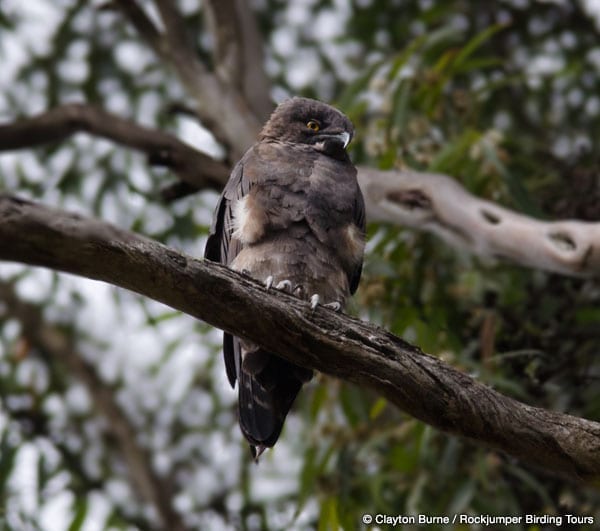
David Hoddinott
The Orange Fruit Dove is found in Fiji. The male has to be one of the most intensely orange birds in the world; it’s truly spectacular! It’s a bird I’d been wanting to see for many years and was therefore particularly delighted to have wonderful views of a male calling on our Fiji, Samoa and Vanuatu tour this year, a fantastic highlight!
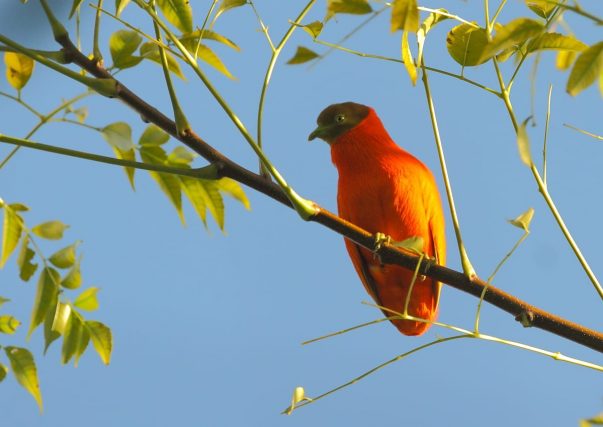
Mark Beevers
My special birds of 2015 were both unexpected rarities in Morocco. The first was a female Lesser Scaup that I found at Oued Massa whilst co-leading the High Atlas and Desert tour with Keith. Oued Massa is one of my favourite birding locations in Morocco and is renowned for its rarity track record. Only the sixth record for Morocco, it was the second that I had found there, having found the second record for Morocco (and mainland Africa) in 2010 whilst co-leading the same tour and less than a mile from the first sighting to boot, coincidence or what?! The other species is Spanish Imperial Eagle, which I found in the Zaer region of Morocco on day 1 of a private tour. This tour was set up to search for specific target species for four top-level Africa listers and despite some fanciful group expectations, this species hadn’t even featured in our wildest dreams. This is the fifth documented record for Morocco but for those on the trip, the way the identification was concluded will be remembered for a long time.
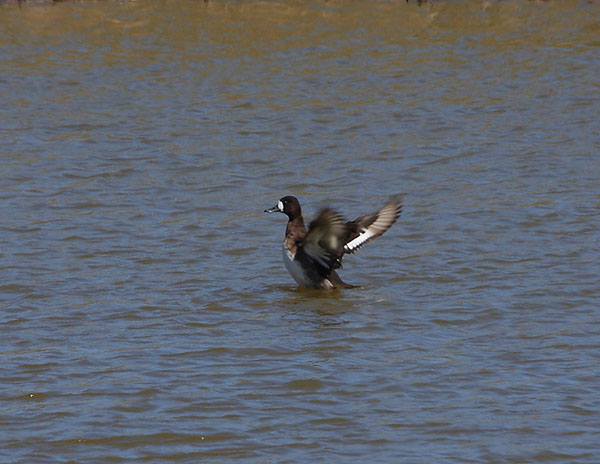
Rob Williams
Having led two great tours in South America, to Northern Peru and the Colombia Mega (1004 species found!), there are a lot of great birds to cast my mind back over. In Colombia, the Hooded Antpitta was a long-awaited lifer for me, as well as the group. The experience of hearing it, tracking it as it moved fast through the understorey, high into the sub-canopy, and eventually getting amazing looks is highly memorable. However, I think my personal bird of the year is the Long-whiskered Owlet which we enjoyed great views of on the northern Peru tour. Not a lifer, but always tricky to see well, and this year we had fantastic views of a very cooperative individual just after dusk. Having previously spent over a week looking for this bird, before its call was known and when it was even thought to possibly be flightless, it was nice to see it well and this was the best look I have ever had!
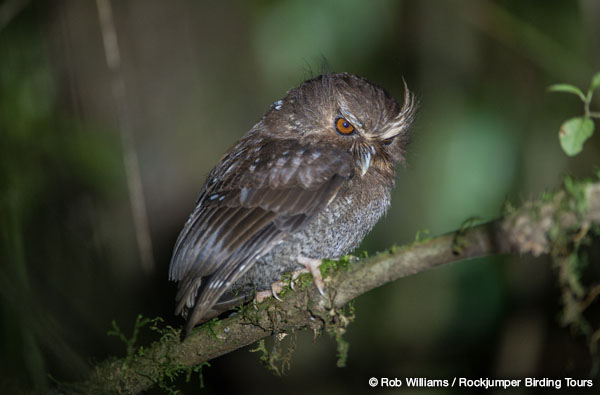
Erik Forsyth
The bird of 2015 for me was without a doubt the Kagu, an endangered flightless bird of the moist forests of central New Caledonia. I had flown over New Caledonia regularly on my annual visit to Papua New Guinea where I lead tours and always said “next time I will go to New Caledonia and look for the Kagu” and this year I decided to do just that.
I arrived in New Caledonia, a former French Colony, in the afternoon, collected my rental car, and noticed that the steering wheel was on the left-hand side and that I would have to learn to drive competently on the right side of the road. This all went fairly well and I negotiated the busy metropolitan outskirts of the capital, Noumea, without incident. Later that evening I arrived at the Blue River National Park, which was closed so I settled down for a night in the car. The following morning dawned sunny and clear and soon I was driving 15km through the park to meet up with Jean-Marc (a conservation guide) on the other side of a pontoon bridge. After chatting, we drove to a moist patch of woodland where Jean-Marc said that there was a resident pair of Kagu. It wasn’t long before a ghostly white shape drifted through the trees and appeared in front of us on the edge of the forest. Suddenly, I was face to face with a bird I had longed to see and watched in awe as this mythical bird stood motionless just a few meters away. A large, white bird with red bill and red legs living in tropical green forest! It was difficult to comprehend what species I was looking at, was it a rail, heron or a ground pigeon … all in all, a mysterious bird! Definitely the bird of 2015 for me.
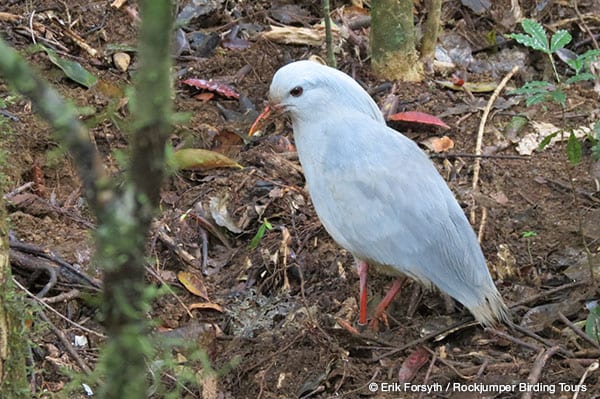
Markus Lilje
We were getting towards the end of a fascinating trip in Loanga National Park in Gabon, with the usual highlights and frustrations of any tour in West and Central Africa. There had been no sign of the large flocks of the still relatively understudied African River Martins that would breed here over the next months. We had picked up many other great birds like White-crested Tiger Heron, Black-headed Bee-eater and White-bibbed Swallow that could all have made this list in their own right. After just having seen a fantastic male Sitatunga from our boat we leant into another river bend, only to see a small flock of African River Martin and Rosy Bee-eater low over the water ahead of us. We were able to get really close and had these strange birds drinking and splashing around us for a few fantastic minutes.
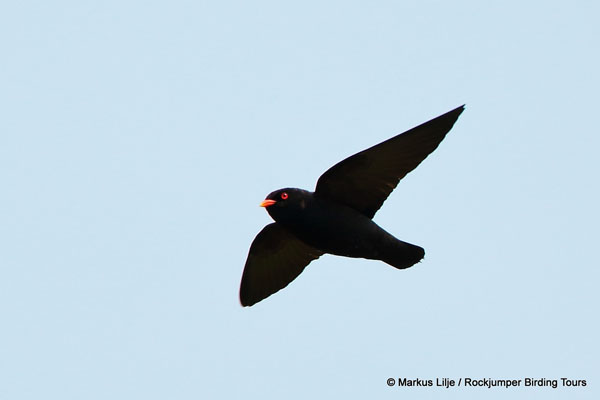
Greg de Klerk
My bird of year for 2015 is a species which had proved rather elusive in for me in South Africa.The Mangrove Kingfisher is found in Mangroves along the eastern coastline of South Africa during the winter non-breeding season only. In the Mangroves the Kingfisher feeds on a host of aquatic creatures including crabs, mudskippers and other fish; while also being partial to insects and small reptiles. This particular individual was a lifer for me and kept us entertained as it flew back and forth, snaring Fiddler Crabs with apparent ease while providing many photo opportunities. A fitting individual for my bird of the year.
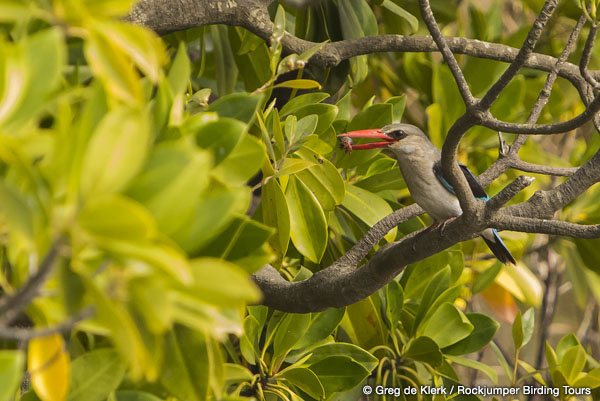
Keith Valentine
The highlight tours for me this year included Ethiopia, Morocco and Ghana. All extremely varied and all providing some outstanding highlights. Choosing from the long list of quality birds was a difficult task; however, at the end of the day, it had to be Nkulengu Rail. I first heard this species calling in Ghana back in 2006. I was fortunate to be able to return on many occasions to Ghana and countries like Cameroon where the species also occurs and managed to hear it on numerous occasions. The species, however, continued to be a ghost for me and after 10 years of searching, I had almost resigned myself to the fact that this amazing rail was destined to always feature only on my heard list. This year I returned to Ghana and, once again, thoughts of Nkulengu Railbegan to make their way into my head. As we got into the rainforest zone, these thoughts began to roll around more and more frequently and by the time we got to Ankasa Forest on day 10 of the tour, I was once again dreaming of this special bird. Our first early morning began as we had grown accustomed to, with an early pre-dawn breakfast, however, just as we sat down, we heard the call of Nkulengu Rail not too far away. A few people then went out to take a look and were quickly able to locate a pair of rails perched about 25 feet up in a large tree. The word quickly got back to camp and before long everyone was enjoying this mega. A fine way to end 2015!
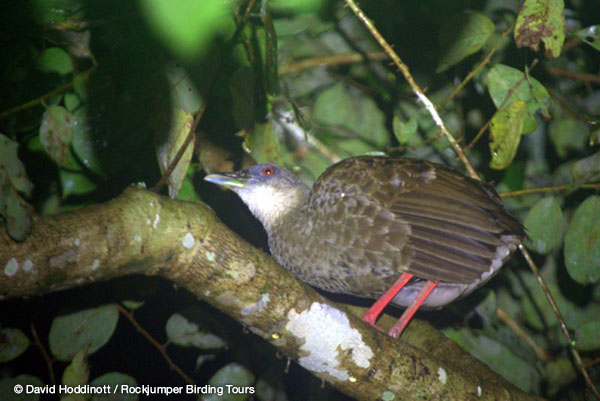
Wayne Jones
I’ve been fortunate to have travelled to some fantastic places this year, and to have seen some truly amazing birds. The one that really stands out, though – even if it might seem an obvious choice – is the (male) Satyr Tragopan, which I saw on our Bhutan I and II tours. It really is an unbelievably stunning animal, and one that I grew up admiring in beautifully illustrated bird books. To see one in the flesh, and to have the quality of the sightings that we did on both our Bhutan tours was special indeed.
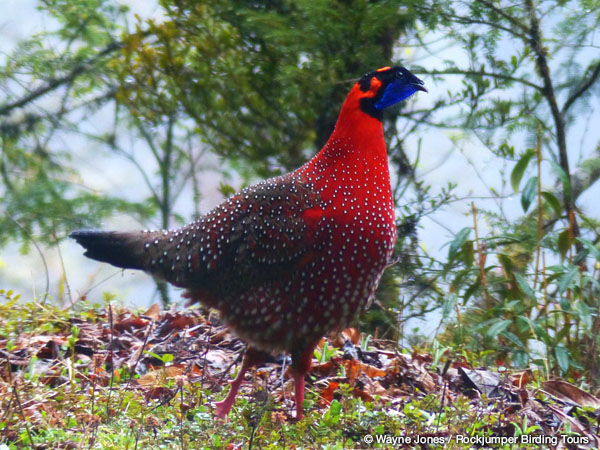
Heinz Ortmann
In 2015 I led a number of tours across Southern Africa, Madagascar and Uganda. The trip to Uganda, in particular, stood out. Although there were many birds to choose from, my bird of the year was an obvious choice. The Shoebill is every bit as strange and bizarre as it looks. Confined to mostly papyrus swamps, this large bird stands motionless as it searches for its usual prey, Lungfish, in shallow water. We were treated to fantastic close up views of this strange stork on our Uganda tours but the first bird I saw is the one that will always stick out as it allowed us to approach within a few metres from where it was standing and did not seem at all bothered by our presence.
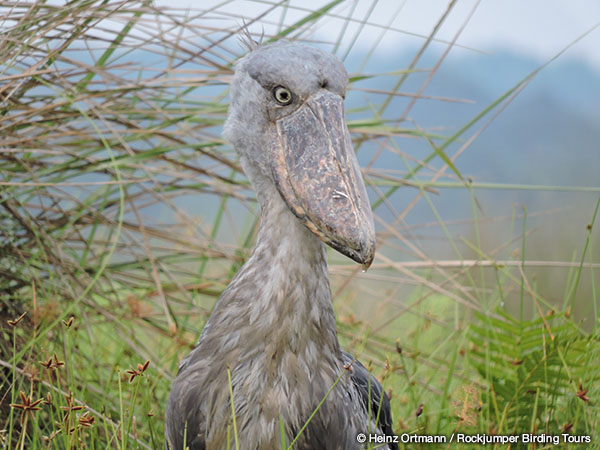
Gareth Robbins
On the last few Eastern South Africa tours, I have been fortunate enough to locate and observe this unique bird in the Sand Forests in and around the Hluhluwe area. Everyone on the tour, including myself, was intrigued by the loud trilling frog-like mechanical sound that is emitted by the African Broadbill during its display. I saw this bird in Angola this year too; but for most of the clients on this particular Eastern South Africa tour, this had been one of the more sought-after birds and is one of the main highlights of the tour.
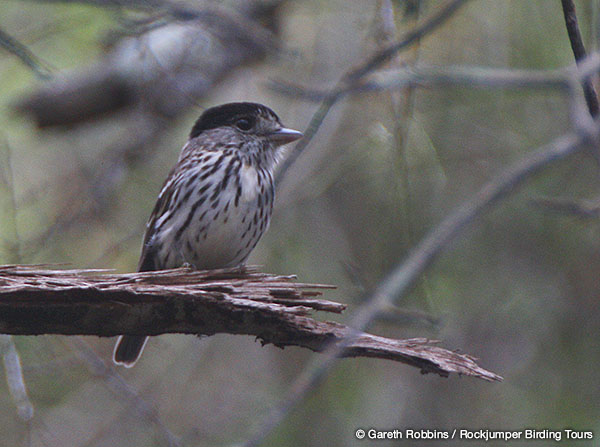
Cuan Rush
Birding with a guest whose world list is well over 7,000 species is somewhat daunting and challenging, mainly because lifers are few and far between for them. However, on tour to East Africa in May this year, we birded the Usambara Mountain range, part of the Eastern Arc Mountains in Tanzania. During the trip, my guest did very well on new birds for his list but one stood out above the rest (in terms of rarity), namely Long-billed Forest Warbler (also known as Long-billed Tailorbird). Not an exceptionally attractive species, it is, however, a highly range restricted and critically endangered bird that occurs at low densities. In the East Usambaras, we travelled to a site where it is known to occur and spent at least an hour searching and listening for the bird. Finally, we heard it call and after persisting for another 10 to 15 minutes we managed to track it down in a dense tangle at the forest edge. We were thrilled to find not only one bird but a family group of 4; 2 adults feeding 2 youngsters. Incredible! Following the group, we had numerous, mostly brief, sightings of the birds as they foraged in the tangles and undergrowth. An amazing birding memory and great to know that the birds are still breeding successfully in the fragmented forest patches.
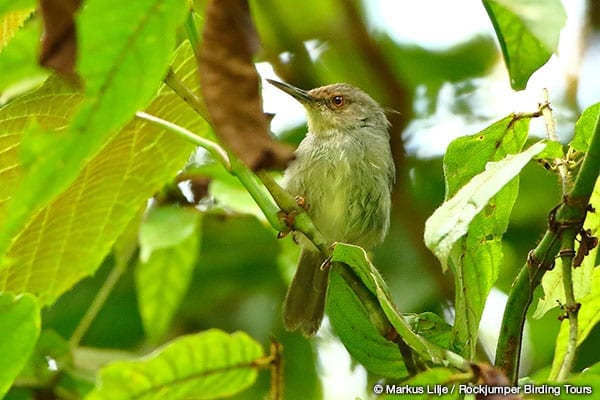
Rich Lindie
Choosing my bird-of-the-year for 2015 seemed infinitely harder than in previous years – not just because I saw well over 2,000 species during those twelve months, but also because the list included the likes of Harpy Eagle, Dark-winged Trumpeter, Alta Floresta Antpitta and White-necked Rockfowl! The only way I could make it much easier was to choose a bird that I had snapped a good picture of. Whittling the list down to just a few hundred, I was immediately grabbed by one in particular, for a pretty special reason.
After a few years without a tour in South America, I landed in Brazil more excited than a kid on Christmas Eve and made my way directly to Intervales, a short drive south of São Paulo – not my top city of the year, just so you know. Arriving there, I immediately began my reintroduction to the bounty that is Neotropical birding, seeing a Red-and-white Crake shortly after. While not in a family restricted to the New World, it was one of the first birds I saw during that reintroduction and it felt like the bang to my start. On top of this, it was my first lifer in South America for quite some time and it also happens to be in one of the families at the top of my interest list.

Adam Walleyn
Melanesia is a favorite region of mine. During a trip through the Solomon Islands this year, we made a visit it to Tetepare – a long-awaited first visit for me. The island holds a claim to being the largest uninhabited island in the tropical Pacific and there has been almost no hunting, fishing, or logging on the island in two decades. Our visit did not disappoint: the island teemed with the most approachable birdlife I have ever encountered in the Solomons, and there was stunning lowland rainforest and amazing marine life. I also knew that the island held the only recent records of the virtually unknown Solomons Nightjar – although I knew of no one who had actually seen the bird! Knowing that the chances of encountering a bird during a daylight visit would be close to nil, I still couldn’t help but ask a local guide if he knew anything of the bird. To our great surprise, he replied that he had seen a roosting bird a couple weeks earlier, but that it was too far to walk there. Fortunately, we had a zodiac and after jumping in and cruising around to the back side of the island, we landed and assembled on shore. Our jaws dropped one by one as we made out the outline of an incredibly-well-camouflaged roosting Solomons Nightjar a few meters away. The image included here is surely one of the only ever taken of the species!
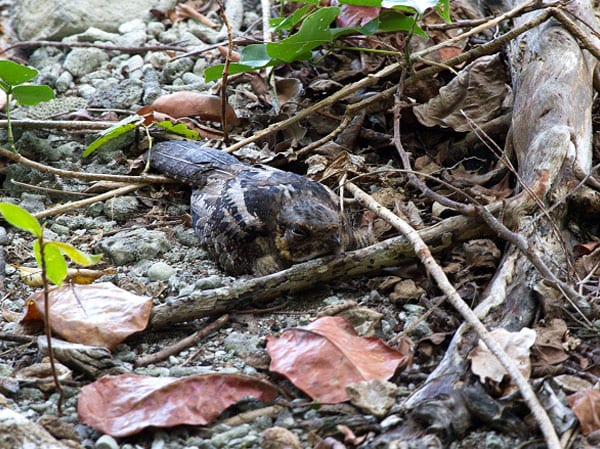
Glen Valentine
Very few birds are as mythical and little-known as the Golden Masked Owl, a gorgeous little Tyto owl that is endemic to the island of New Britain, which in turn is a small, under-explored island situated off the east coast of New Guinea.
This species was, until very recently, only known from a handful of specimens and sight records until its rediscovery a few months ago. With much excitement and anticipation, we arrived in Hoskins to begin our first of several New Britain tours for the 2015 New Guinea season. As soon as we arrived at our lodge in Kimbe Bay we met with Joseph – the lodge’s local guide and the man responsible for rediscovering the species – and formulated a plan on how we were going to try and find this mythical species and on the second night we left the luxuries of our wonderful lodge and embarked on our Golden Masked Owl quest. We drove along the road where Joseph had seen the owl a few weeks prior to our visit and also scoured every other gravel track that bisected the general area but to no avail. A little disappointed, but not in the least bit surprised, we returned to the lodge empty-handed. On our third night we ventured out again but this time we’d literally just left the lodge and driven about two hundred meters along a gravel, oil-palm harvesting road when Joseph reminded us that this was the place where he and Shane – the lodge manager – had videoed the owl a few weeks earlier. Almost as soon as he finished his statement our lights met an object perched on a low stump at the edge of the road and right in the middle of a large oil palm plantation! We couldn’t believe it! Our hearts skipped a beat when we realized that it was indeed a Golden Masked Owl! We were almost too excited to even think. We couldn’t believe our luck and the fact that we were actually admiring this once impossible-to-see owl in the wild!
We decided to return the next night, our final night on the island, and quite amazingly, there it was, sitting on a similar post in the same area as the previous night. We enjoyed further, excellent views before it took flight into the plantation. However, we managed to re-unite with it again on another nearby track and were treated to final satiating views of this beautiful and exceedingly rare species before we bid farewell to one of the rarest birds on earth. This was indeed a very special birding moment and one that we will all cherish forever!
Unfortunately, we were unable to find the owl on our second and third New Britain tours so one has to wonder, when will Golden Masked Owl be seen again? Will it become an annual event or will it once again remain an unknown, unseen “phantom” for the next few decades…
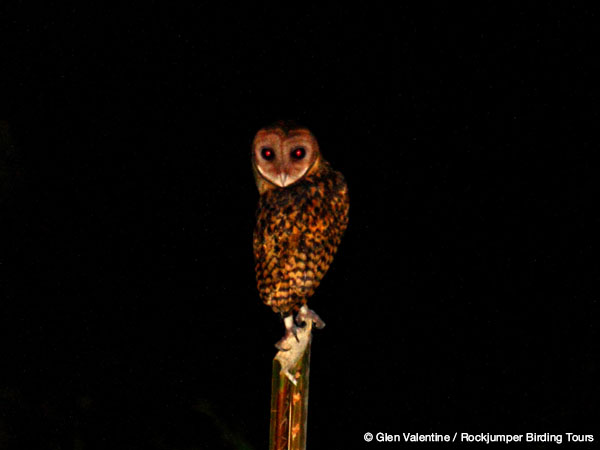
Forrest Rowland
My touring year of 2015 was spent entirely in the Western Hemisphere. Being unabashedly vocal about my love of all things Neotropic, this suited me fine. Despite there being relatively little left in the ‘Lifer’ column of my IOC checklist on this half of the planet, I always enjoy birding the tropical Americas. I take into account that this hemisphere represents well more than half the world’s birds, and there are still many wondrous nooks and crannies left to explore.
The opportunity to guide our inaugural tour through Bolivia was, by far, the most personally rewarding experience of this great year. New habitats, new microhabitats, new logistical challenges, and many new fantastic species of birds greeted me there. While Hooded Mountain-Toucan is a strong contender, being both quite rare, exceptionally attractive, and my 3000th species for the South American continent, another more diminutive ‘Hooded’ member of the avian world wins my Bird-of-the-Year honor – the tiny, endearing, inexplicably rare Hooded Antpitta.
As a Neotropic enthusiast, I’m enamoured with all things ‘Ant’-related. Antbirds, Antwrens, and Antpittas call to my inner masochist, given that most of these creatures inhabit the densest, darkest thickets and forests. The scarcest of these skulkers are only found in the most remote areas of an already hard-to-access continent. Hooded Antpitta is among the most enigmatic of these already mythical critters known as Antpittas. Online resources reporting the Life History of this particular species are starkly void of any information. Save for the anecdotal reference of one or two of the few observers who have seen this species, the information is mostly an educated guess referencing a well-studied relative, at best. There is little-to-no concrete information about this beautiful little bird which makes it all the more enticing to someone like me!
Having spent one or two months of my life in Colombia, each year, for the past 12 years, I have a vested interest in all things Colombian. Nothing is more Colombian than the special birds that occur there. Only a very few species remain, for me, in Colombia. Hooded Antpitta was one of only five or six new species I could see in the country, when we found ourselves staring at not one, but TWO individuals, right in the face, on December 15th of this year! To say I was beside myself is a complete understatement. After initial great looks at the pair, close, at eye-level, in relatively open vegetation (see the accompanying photo by tour participant Paul Ippolito to get an idea of the circumstance and proximity), I literally had to walk away for a few seconds to collect myself. This was more than just the bird experience of the year for me. It was, perhaps, the bird of the decade, to date!
